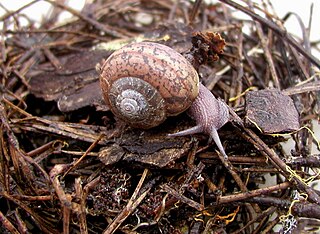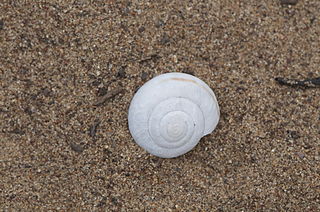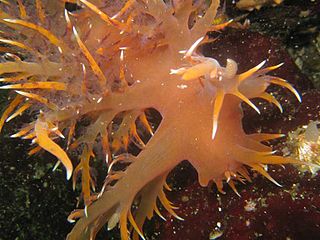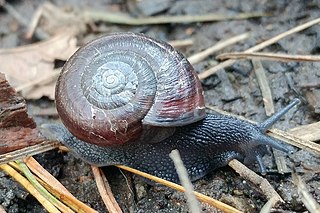
Thomas Say was an American entomologist, conchologist, and herpetologist. His studies of insects and shells, numerous contributions to scientific journals, and scientific expeditions to Florida, Georgia, the Rocky Mountains, Mexico, and elsewhere made him an internationally known naturalist. Say has been called the father of American descriptive entomology and American conchology. He served as librarian for the Academy of Natural Sciences of Philadelphia, curator at the American Philosophical Society, and professor of natural history at the University of Pennsylvania.

The grove snail, brown-lipped snail or lemon snail is a species of air-breathing land snail, a terrestrial pulmonate gastropod mollusc.
Shell money is a medium of exchange similar to coin money and other forms of commodity money, and was once commonly used in many parts of the world. Shell money usually consisted of whole or partial sea shells, often worked into beads or otherwise shaped. The use of shells in trade began as direct commodity exchange, the shells having use-value as body ornamentation. The distinction between beads as commodities and beads as money has been the subject of debate among economic anthropologists.

Calliostoma is a genus of small to medium-sized sea snails with gills and an operculum, marine gastropod molluscs within the family Calliostomatidae, the Calliostoma top snails. Previously this genus was placed within the family Trochidae. Calliostoma is the type genus of the family Calliostomatidae.

Helminthoglypta is a genus of air-breathing land snails, terrestrial pulmonate gastropod mollusks in the subfamily Helminthoglyptinae of the family Xanthonychidae.

The banded dune snail or Morro shoulderband(Helminthoglypta walkeriana) is a species of endangered air-breathing land snail, a terrestrial pulmonate gastropod mollusc in the subfamily Helminthoglyptinae.

Diaulula sandiegensis is a species of sea slug, a dorid nudibranch, a shell-less marine gastropod mollusc in the family Discodorididae.

Helminthoglypta nickliniana, common name "Nicklin's Peninsula snail" or "Coast Range shoulderband" is a species of air-breathing land snail, a terrestrial pulmonate gastropod mollusk in the family Helminthoglyptidae.

Helminthoglypta tudiculata, common names the southern California shoulderband or southern shoulderband, is a species of air-breathing land snail, a terrestrial pulmonate gastropod mollusk in the family Helminthoglyptidae.

Californiconus californicus, commonly called the Californian cone, is a species of small, predatory sea snail in the family Conidae, the cone snails.

Callianax biplicata, common names the purple dwarf olive, purple olive shell, or purple olivella is a species of small predatory sea snail, a marine gastropod mollusc in the family Olividae, the olives.

Dendronotus iris, also known as the rainbow nudibranch, is a species of sea slug, a dendronotid nudibranch, a shell-less marine gastropod mollusc in the family Dendronotidae.

Henry Hemphill (1830–1914) was an American malacologist, a biologist who studies mollusks. In particular he studied land and freshwater mollusca.

The marine snail Norrisia norrisii is a medium-sized gastropod mollusk within the family Tegulidae. It has several common names, including Norris's top snail, Norris's topsnail, norrissnail, smooth brown turban snail, or kelp snail. It was first described by G.B. Sowerby I under the name Trochiscus norrisii.

Haliotis fulgens, commonly called the green abalone, is a species of large sea snail, a marine gastropod mollusc in the family Haliotidae, the abalones. The shell of this species is usually brown, and is marked with many low, flat-topped ribs which run parallel to the five to seven open respiratory pores that are elevated above the shell's surface. The inside of the shell is an iridescent blue and green.

Rapa rapa, common name the bubble turnip, is a species of sea snail, a marine gastropod mollusk in the family Muricidae, the murex snails or rock snails.

Kelletia kelletii, common name Kellet's whelk, is a species of large sea snail, a whelk, a marine gastropod mollusc in the family Buccinidae, the true whelks.

Kelletia is a genus of large sea snails, whelks, a marine gastropod molluscs in the family Austrosiphonidae, the true whelks.

Eulithidium comptum, the Californian banded pheasant shell, is a species of small sea snail with calcareous opercula, a marine gastropod mollusk in the family Phasianellidae, the pheasant snails.

Helminthoglypta sequoicola, the redwood shoulderband snail, is a North American species of air-breathing land snail. Two subspecies are recognized:




















